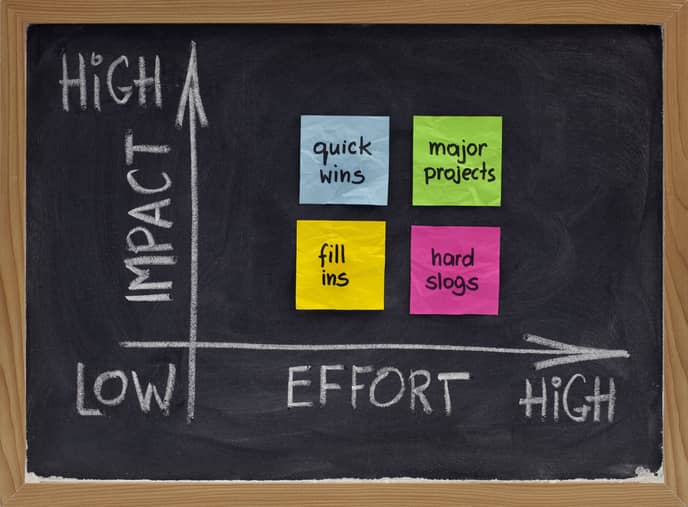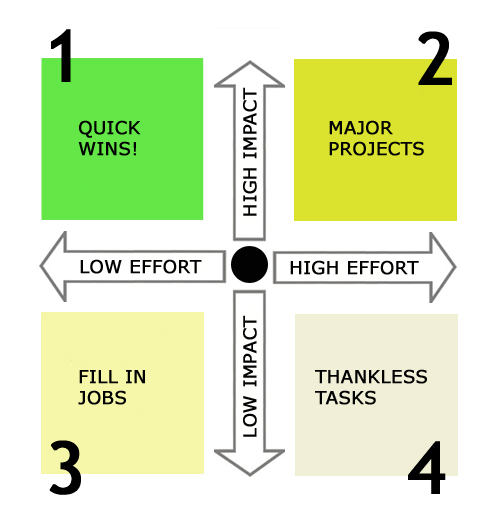A Kaizen Event is designed to support an effective, short-term brainstorming session that focuses on a single challenge and improves an existing process. The term is loosely translated from the Japanese to “change for the good.”
As with many strategies involved in Lean and Six Sigma, the governing idea behind a Kaizen Event is focus and speed. By bringing together the right team to work on an issue, businesses can achieve breakthroughs that quickly lead to process improvements.
A Kaizen Event typically lasts three to five days. While the event itself is short, it’s a strategy that businesses should make a routine part of their long-term process improvement plans.
Who is Involved with a Kaizen Event?
The only criteria for invitation to a Kaizen Event is having knowledge and a stake in the process under discussion. That can include employees, managers and C-suite executives. One of the major tenets of Lean and Six Sigma is that they draw on expertise from all levels of the organizational chart.
The key to Kaizen Event success is having the right people involved. They need to feel motivated to find solutions that will better a process and also have a deep understanding of the process under consideration.
When Should Businesses Use a Kaizen Event?
The reasons for a Kaizen Event vary depending on the organizations involved. Typically, an operation is not working as planned and teams need a brainstorming session to find the root cause of the problem and potential solutions.
The problem itself often involves some form of waste. This includes any actions that don’t add value to the end user. In the worst cases, waste can keep a product or service from meeting a customer’s needs.
Eight Wastes of Lean
The eight wastes of Lean that Kaizen Events often focus on eliminating include:
- Defects: Defects cost time and money, as well as increase the risk of not meeting customer requirements.
- Overproduction: Creating more products than needed to meet demand.
- Waiting: Time employees or machines sit idle, waiting for completion of previous steps in an operation.
- Non-utilized talent: Not making use of all the employee talents and skills at your disposal.
- Transportation: Creating transportation systems that are longer than needed.
- Excess inventory: The cost of warehousing excess supplies, materials, and products.
- Motion: Unnecessary actions by employees or machines.
- Extra processing: Unneeded steps in an operation that do not add value, such as requiring too many people to sign off on a document.
When to Use a Kaizen Event
While many Kaizen Events focus on these areas of waste, the situation that makes the need for a Kaizen Event clear doesn’t always – at least initially – seem related to these areas. A Kaizen Event can become necessary for any of the following reasons, according to Reliable Plant.
An urgent problem arises: These often take the form of an increase in defective products or services, a failed inspection, or a sudden increase in customer complaints.
A need to hit target goals: A Kaizen Event can help departments or teams hit KPIs or strategic goals, especially if this has been an issue in the past.
When daily improvements have proven ineffective: Kaizen Events encourage employees and managers to get out of the rut of daily schedules and make changes in their day-to-day routine that improve operations.
For cross-functional collaboration: Any project requiring cross-functional collaboration is difficult to complete successfully. A Kaizen Event allows people from different areas of a business to better combine their talents in achieving a common goal.
The Kaizen Culture
Another advantage of a Kaizen Event is that they show managers and employees ways to foster a Kaizen mindset toward their work. This “Kaizen Culture” focuses on continuous process improvement and finding ways to change daily routines that can result in better results for both the short term and long term. A Kaizen Event also shows each employee how what they do has a significant impact on company operations and customer satisfaction.
How a Kaizen Event Works
While the details may differ depending on who oversees the Kaizen Event, it typically breaks down into the following areas.
Kaizen Event Preparation
The most important part of the event. Team leaders define the problem that the event will address, as well as the goal and scope of the project. Those invited to the team should now the desired outcome of their efforts.
Preparation also includes a problem statement. This answers questions such as:
- What is occurring (or not occurring) that is causing the issue?
- Where in the process and when does the problem occur?
- Who is impacted by the problem?
- What is the ultimate impact of the problem in areas such as lowered customer satisfaction, higher costs and wasted time?
Kaizen Event Training
In order to break down the details of an operation and find the root cause of issues, team members must receive the proper process improvement training. They should know the basic methods, tools and goals of Lean and Six Sigma, as well as the governing principles behind the methodologies. Training should especially focus on root cause analysis and value stream mapping (of both the current and desired future state of operations).
Kaizen Event Implementation
By mapping out the current process, teams will find waste, redundancies, bottlenecks and defects in a process. They then can map out a desired future state and create a series of steps to reach that goal. Teams must make every phase of preparation, training and implementation data-driven. That extends to measuring the results of changes in quality and productivity, cost and time management.
Kaizen Event Follow Up
In addition to capturing data on the changes in key areas, the follow up to a Kaizen Event should include speaking with individual team members involved in the process. Through them, teams can better determine the impact of changes and whether the Kaizen Event was successful. They also can identify areas that require further improvement.



